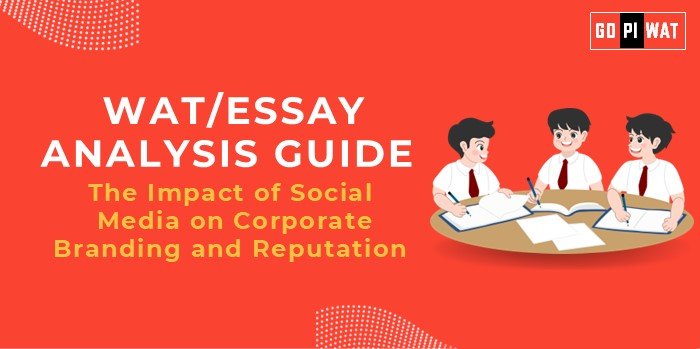📋 WAT/Essay Analysis Guide
🌐 Topic: The Impact of Social Media on Corporate Branding and Reputation
💡 1. Understanding the Importance of Social Media in a B-School Context
In today’s digital era, social media is a game-changer for corporate branding and reputation management. For B-school students, analyzing this topic provides insight into modern marketing strategies, crisis management, and stakeholder engagement. Social media’s role in shaping consumer behavior, fostering transparency, and amplifying brand narratives is indispensable for future leaders navigating an interconnected global marketplace. It also sharpens critical thinking, data-driven decision-making, and innovative problem-solving skills.
⏳ 2. Advanced Planning and Structure Strategy
- Time Allocation Tips:
- 🕒 Brainstorming (5 minutes): Identify key examples of social media successes and crises, and frame your thesis.
- 📜 Outlining (5 minutes): Organize the essay into sections—achievements, challenges, and recommendations.
- ✍️ Writing (15 minutes): Craft focused paragraphs with clear topic sentences and supporting evidence.
- 🔍 Reviewing (5 minutes): Ensure logical flow, impactful transitions, and error-free writing.
- Preparation Techniques:
- Identify relevant examples: Research iconic campaigns (e.g., Nike’s bold messaging) and controversies (e.g., Starbucks’ backlash on social issues).
- Understand algorithms: Analyze how platforms amplify or diminish brand visibility.
- Incorporate stakeholder perspectives: Include consumer, corporate, and regulatory viewpoints to add depth.
📄 3. In-Depth Introduction Techniques for Essays
- Data-Driven Introduction: “In 2023, over 93% of global businesses used social media for marketing. Yet, controversies like backlash over insensitive ads highlight its double-edged nature for corporate branding.”
- Analytical Introduction: “Social media, while enabling real-time engagement, has exposed brands to unprecedented scrutiny, compelling organizations to rethink their communication strategies.”
- Comparative Introduction: “While brands in the U.S. leverage social media for activism, Indian companies focus on cost-effective outreach, highlighting distinct strategies across markets.”
📊 4. Comprehensive Structure for Essay Body
1. Achievements and Supporting Data:
- Discuss successful campaigns like Coca-Cola’s “Share a Coke” for emotional connection.
- Explore employee branding via LinkedIn and influencer partnerships on Instagram.
- Highlight metrics, e.g., increased ROI from targeted ad campaigns.
2. Challenges with Comparative Analysis:
- Examine risks like viral misinformation damaging brand trust.
- Provide international comparisons, e.g., Nike’s controversial Colin Kaepernick ad’s polarized reception versus Dove’s universally praised body positivity campaigns.
3. Future Outlook:
- Address emerging trends like AI-driven personalization and ethical advertising.
- Discuss regulatory shifts and platform policies influencing branding strategies.
🔍 5. Detailed Conclusion Techniques with Global Relevance
- Balanced Perspective: “Social media has transformed corporate branding, offering both immense potential and considerable risks. By balancing authenticity with proactive risk management, brands can sustain their reputation in this volatile digital age.”
- Global Comparative Conclusion: “As global case studies reveal, successful branding on social media hinges on cultural sensitivity, data-driven strategies, and ethical storytelling—a model adaptable to diverse markets.”
✨ 6. Expanded Analysis of Key Achievements and Shortcomings
- Achievements:
- ✔️ Real-time consumer engagement has redefined customer service.
- ✔️ Social media platforms serve as cost-effective tools for global outreach.
- ✔️ Examples: Zomato’s witty Twitter responses and Airbnb’s user-generated content campaigns.
- Challenges:
- ⚠️ Misinformation and brand boycotts can escalate rapidly.
- ⚠️ Balancing transparency with strategic messaging remains complex.
- Example: Facebook faced backlash for perceived data mismanagement, affecting its credibility.
- Global Context:
- 🌍 Compare approaches, such as India’s focus on regional engagement versus the U.S.’s emphasis on activism-driven branding.
- 🌍 Highlight how regulations like Europe’s GDPR impact branding dynamics.
✍️ 7. Two Full 500-Word Sample Essays Demonstrating Different Approaches
Essay 1: Balanced Perspective Approach
Introduction: Social media has revolutionized corporate branding, enabling real-time engagement and fostering global reach. While successes like Coca-Cola’s campaigns showcase its potential, failures like United Airlines’ PR crises underline the risks.
Body:
- Social media’s achievements are transformative. Campaigns like Dove’s “Real Beauty” resonate emotionally, boosting brand equity. Platforms like LinkedIn empower employee branding, enhancing talent acquisition.
- However, the digital landscape is fraught with challenges. Viral misinformation can erode trust overnight, as seen in Starbucks’ backlash for alleged racial insensitivity. Comparatively, proactive engagement strategies in Europe, such as GDPR-aligned transparency, mitigate such risks.
Conclusion: While social media remains a dynamic branding tool, companies must navigate its pitfalls with agility and foresight. Balancing creativity with authenticity ensures sustainable brand growth.
Essay 2: Solution-Oriented Approach
Introduction: In the fast-paced digital era, social media offers brands an unparalleled platform for engagement. However, mismanagement of its risks can swiftly tarnish reputations. By leveraging AI for personalization and fostering transparency, companies can maximize its benefits.
Body:
- The challenges are multifaceted. Missteps, like Pepsi’s poorly received protest ad, highlight the need for cultural sensitivity. Additionally, algorithmic biases can alienate key demographics.
- Solutions lie in proactive strategies:
- AI tools can personalize content delivery while ethical guidelines ensure culturally appropriate messaging.
- Regulatory adherence, akin to Europe’s GDPR, can further bolster trust.
Conclusion: Social media’s transformative potential hinges on innovative and ethical usage. With forward-thinking strategies, brands can lead in this evolving digital landscape, setting benchmarks for responsible engagement.


